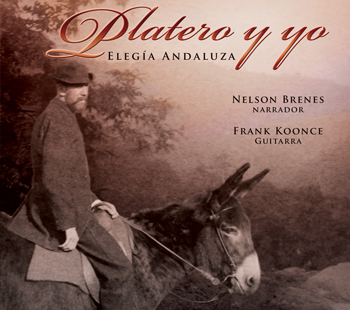Platero and I is a captivating book of prose, the crowning achievement of Nobel Prize-winning writer Juan Ramón Jiménez. Subtitled 'Andalusian elegy,' it is a reflection of the experiences of Jiménez and Platero (from 'plata y oro'), a little donkey to whom the poet confided his thoughts, feelings, and observations about daily life in his village of Moguer, Spain, at the turn of the twentieth century.
Twenty-eight of the verses from Platero y yo were set to music for classical guitar in 1960 by the Italian-born American composer Mario Castelnuovo-Tedesco. Soon afterwards, Andrés Segovia recorded ten of them without narration, since much of the musical score sounds complete by itself. Both the music and the text, independent of one another, are profoundly expressive and moving; but together they become a true masterpiece. This recording features 17 selections from Platero y yo performed by narrator Nelson Brenes and guitarist Frank Koonce.
Producer: Frank Koonce
Co-producer: Nelson Brenes
Recording and editing: Todd Hallawell and Eduardo Ortiz Monestel.
Mastering: Ben Taylor
Art and design: Leanne Koonce
The cover artwork was adapted and colorized from a nineteenth-century photograph by T.H. Lindsey. The booklet illustrations are by Maud and Miska Petersham (1922).
© 2008, Frank Koonce and Nelson Brenes
© English translation: 2008, Frank Koonce
© Music: 1973, Edizioni Musicali Bérben
All rights reserved.
Juan Ramón Jiménez (1881-1958) was born in the Andalusian town of Moguer. He wrote over twenty-five volumes of poetry, including Platero and I (1907-1916), the best known of his prose works. The Spanish Civil War forced Jiménez and his wife, Zenobia, to flee their homeland in 1936. After spending time in the United States and Cuba, the couple made their final home in Puerto Rico. Jiménez received the Nobel Prize for Literature in 1956, three davs before his wife's death. Heartbroken by her passing and being in poor health, he died two years later.
The first complete edition of Platero and I appeared in 1917. Earlier, an abridged edition of selected verses had been published for children, for which Jiménez notes:
Some people believe that I wrote Platero y yo for children, that this is a book for children. No. In 1913, the editor of La Lectura, who knew that I was writing this book, asked me to advance a few of its most idyllic pages for its 'youth series.' Then, changing my idea momentarily, 1 wrote this prologue:
A NOTE TO THOSE GROWNUPS WHO
READ THIS BOOK TO CHILDREN
This short book, in which joy and sadness are twins, like the ears of Platero, was written for... I don't know for whom!... for whomever lyric poets write... Now that it goes to the children, I do not add nor remove a single comma. That's it!
'Wherever there are children' says Novalis, 'there exists a Golden Age.' Since it is within this Golden Age, which is like a spiritual island fallen from the sky, that the heart of the poet walks and finds so much to his liking, that his greatest desire would be to never leave.
Island of grace, of freshness and of happiness, Golden Age of the children: I always found you in my life, sea of mourning; let your breeze lend me its lyre, high, and, at times, without reason, like the trill of the lark in the white sun of the dawn!
THE POET
Madrid, 1914
Mario Castelnuovo-Tedesco (1895-1968) spent his youth in Florence, Italy, where he attended the Cherubini Royal Conservatory of Music and earned degrees in piano and in Composition. He became widely known in Europe during the 1920s as a concert pianist and composer. In 1939, because of the emergence of Fascism in Italy and Mussolini's anti-Semitic policies, he immigrated to the United States, settling in California after a two-year Stay in New York.
A highly skilled and prolific composer, Castelnuovo-Tedesco wrote in almost every musical form. His most celebrated works include the opera La Mandragola, overtures to twelve plays by Shakespeare (many of whose sonnets and poems he set to music), and two Shakespearian operas, The Merchant of Venice and All's Well that Ends Well. He also wrote solos, concertos, and chamber music for a variety of instruments, over 200 songs, and over 300 scores for the motion picture industry, among them Gaslight, And Then There Were None, The Loves of Carmen, The Yearling, and The Mask of the Avenger.
Castelnuovo-Tedesco's students include noted composers Andre Previn, Henry Mancini, and Jerry Goldsmith, and guitarist Ronald Purcell, who provides us with this personal testimonial:
With an uncanny sense of history, Mario Castelnuovo-Tedesco aligned himself with oral traditions, famous painters, and literary masterpieces, and he created musical moods evoking the emotional content of any text or graphic artwork. His compositional style is so heterogeneous that one hears in his works all musical styles that have come down through the ages. Platero and I is an excellent example of this symbiotic relationship between the composer and the story woven by Juan Ramón Jiménez. Castelnuovo-Tedesco's works are refreshing, eloquent, and sing the 'Song of Songs', and will continue to please audiences for generations to come.
Twenty-eight of the verses from Platero y yo were set to music for classical guitar in 1960 by the Italian-born American composer Mario Castelnuovo-Tedesco. Soon afterwards, Andrés Segovia recorded ten of them without narration, since much of the musical score sounds complete by itself. Both the music and the text, independent of one another, are profoundly expressive and moving; but together they become a true masterpiece. This recording features 17 selections from Platero y yo performed by narrator Nelson Brenes and guitarist Frank Koonce.
Producer: Frank Koonce
Co-producer: Nelson Brenes
Recording and editing: Todd Hallawell and Eduardo Ortiz Monestel.
Mastering: Ben Taylor
Art and design: Leanne Koonce
The cover artwork was adapted and colorized from a nineteenth-century photograph by T.H. Lindsey. The booklet illustrations are by Maud and Miska Petersham (1922).
© 2008, Frank Koonce and Nelson Brenes
© English translation: 2008, Frank Koonce
© Music: 1973, Edizioni Musicali Bérben
All rights reserved.
Juan Ramón Jiménez (1881-1958) was born in the Andalusian town of Moguer. He wrote over twenty-five volumes of poetry, including Platero and I (1907-1916), the best known of his prose works. The Spanish Civil War forced Jiménez and his wife, Zenobia, to flee their homeland in 1936. After spending time in the United States and Cuba, the couple made their final home in Puerto Rico. Jiménez received the Nobel Prize for Literature in 1956, three davs before his wife's death. Heartbroken by her passing and being in poor health, he died two years later.
The first complete edition of Platero and I appeared in 1917. Earlier, an abridged edition of selected verses had been published for children, for which Jiménez notes:
Some people believe that I wrote Platero y yo for children, that this is a book for children. No. In 1913, the editor of La Lectura, who knew that I was writing this book, asked me to advance a few of its most idyllic pages for its 'youth series.' Then, changing my idea momentarily, 1 wrote this prologue:
A NOTE TO THOSE GROWNUPS WHO
READ THIS BOOK TO CHILDREN
This short book, in which joy and sadness are twins, like the ears of Platero, was written for... I don't know for whom!... for whomever lyric poets write... Now that it goes to the children, I do not add nor remove a single comma. That's it!
'Wherever there are children' says Novalis, 'there exists a Golden Age.' Since it is within this Golden Age, which is like a spiritual island fallen from the sky, that the heart of the poet walks and finds so much to his liking, that his greatest desire would be to never leave.
Island of grace, of freshness and of happiness, Golden Age of the children: I always found you in my life, sea of mourning; let your breeze lend me its lyre, high, and, at times, without reason, like the trill of the lark in the white sun of the dawn!
THE POET
Madrid, 1914
Mario Castelnuovo-Tedesco (1895-1968) spent his youth in Florence, Italy, where he attended the Cherubini Royal Conservatory of Music and earned degrees in piano and in Composition. He became widely known in Europe during the 1920s as a concert pianist and composer. In 1939, because of the emergence of Fascism in Italy and Mussolini's anti-Semitic policies, he immigrated to the United States, settling in California after a two-year Stay in New York.
A highly skilled and prolific composer, Castelnuovo-Tedesco wrote in almost every musical form. His most celebrated works include the opera La Mandragola, overtures to twelve plays by Shakespeare (many of whose sonnets and poems he set to music), and two Shakespearian operas, The Merchant of Venice and All's Well that Ends Well. He also wrote solos, concertos, and chamber music for a variety of instruments, over 200 songs, and over 300 scores for the motion picture industry, among them Gaslight, And Then There Were None, The Loves of Carmen, The Yearling, and The Mask of the Avenger.
Castelnuovo-Tedesco's students include noted composers Andre Previn, Henry Mancini, and Jerry Goldsmith, and guitarist Ronald Purcell, who provides us with this personal testimonial:
With an uncanny sense of history, Mario Castelnuovo-Tedesco aligned himself with oral traditions, famous painters, and literary masterpieces, and he created musical moods evoking the emotional content of any text or graphic artwork. His compositional style is so heterogeneous that one hears in his works all musical styles that have come down through the ages. Platero and I is an excellent example of this symbiotic relationship between the composer and the story woven by Juan Ramón Jiménez. Castelnuovo-Tedesco's works are refreshing, eloquent, and sing the 'Song of Songs', and will continue to please audiences for generations to come.




